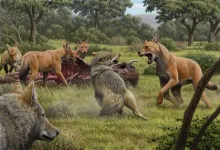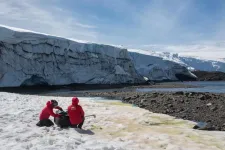The study, which puts to bed a mystery that biologists have pondered for more than 100 years, was led by researchers from UCLA, along with colleagues from Durham University in the U.K., Australia's Adelaide University and Germany's Ludwig Maximilian University.
"The terrifying dire wolf, a legendary symbol of Los Angeles and the La Brea Tar Pits, has earned its place among the many large, unique species that went extinct at the end of the Pleistocene epoch," said UCLA's Robert Wayne, a distinguished professor of ecology and evolutionary biology and the study's co-senior author. The Pleistocene, commonly called the Ice Age, ended roughly 11,700 years ago.
More than 4,000 dire wolves have been excavated from the La Brea Tar Pits, but scientists have known little about their evolution or the reasons for their ultimate disappearance. Gray wolves, also found in the fossil-rich pits, have survived until this day.
"Dire wolves have always been an iconic representation of the last ice age in the Americas, but what we know about their evolutionary history has been limited to what we can see from the size and shape of their bones," said co-lead author Angela Perri of Durham University.
Those bones are now revealing much more. Using cutting-edge molecular approaches to analyze five dire wolf genomes from fossil bones dating back 13,000 to 50,000 years ago, the researchers were able to reconstruct the evolutionary history of the long-extinct carnivore for the first time.
Significantly, they found no evidence for the flow of genes between dire wolves and either North American gray wolves or coyotes. The absence of any genetic transference indicates that dire wolves evolved in isolation from the Ice Age ancestors of these other species.
"We have found the dire wolf is not closely related to the gray wolf. Further, we've shown that the dire wolf never interbred with the gray wolf," said co-lead author Alice Mouton, who conducted the research as a UCLA postdoctoral scholar in ecology and evolutionary biology in Wayne's laboratory.
The ancestors of the gray wolf and the much smaller coyote evolved in Eurasia and are thought to have moved into North America less than 1.37 million years ago, relatively recently in evolutionary time. The dire wolf, on the other hand, based on its genetic difference from those species, is now believed to have originated in the Americas.
"When we first started this study, we thought that dire wolves were just beefed-up gray wolves, so we were surprised to learn how extremely genetically different they were, so much so that they likely could not have interbred," said the study's last author, Laurent Frantz, a professor at Ludwig Maximillian University and the U.K.'s Queen Mary University. "This must mean that dire wolves were isolated in North America for a very long time to become so genetically distinct."
"Dire wolves are sometimes portrayed as mythical creatures -- giant wolves prowling bleak frozen landscapes -- but reality turns out to be even more interesting," said Kieren Mitchell of Adelaide University, a co-lead author.
The dire wolf was a 'lone wolf' when it came to breeding
Interbreeding is quite common among wolf lineages when their geographical ranges overlap. Modern gray wolves and coyotes, for example, frequently interbreed in North America. Yet the researchers, using a data set that included a Pleistocene dire wolf, 22 modern North American gray wolves and coyotes, and three ancient dogs, found that the dire wolf hadn't interbred with any of the others -- likely because it was genetically unable to reproduce with those species.
"Our finding of no evidence for gene flow between dire wolves and gray wolves or coyotes, despite the substantial range overlap during the Late Pleistocene, suggests that the common ancestor of gray wolves and coyotes probably evolved in geographical isolation from members of the dire wolf lineage," Wayne said. "This result is consistent with the hypothesis that dire wolves originated in the Americas."
Another hypothesis about the dire wolf -- one untested in the current study -- concerns its extinction. It is commonly thought that because of its body size -- larger than gray wolves and coyotes -- the dire wolf was more specialized for hunting large prey and was unable to survive the extinction of its regular food sources. A lack of interbreeding may have hastened its demise, suggested Mouton, now a postdoctoral researcher at Belgium's University of Liege.
"Perhaps the dire wolf's inability to interbreed did not provide necessary new traits that might have allowed them to survive," she said.
Uncovering the mystery of the dire wolf's DNA
While the dire wolves sequenced in this study possessed no ancestry from gray wolves, coyotes or their recent North American ancestors, a comparison of the DNA of dire wolves with that of gray wolves, coyotes and a wide variety of other wolf-like species revealed a common but distant evolutionary relationship.
"The ancestors of dire wolves likely diverged from those of gray wolves more than 5 million years ago -- it was a great surprise to discover that this divergence occurred so early," Mouton said. "This finding highlights how special and unique the dire wolf was."
Based on their genomic analyses, the researchers also concluded that there are three primary lineages that descend from the shared ancestry: dire wolves, African jackals and a group comprising all other existing wolf-like species, including the gray wolf.
Gray wolves, which today live mostly in wilderness and remote regions of North America, are more closely related to African wild dogs and Ethiopian wolves than to dire wolves, Wayne noted.
The study is the first ever to report genome-wide data on dire wolves.
The genomic analyses -- conducted in a joint effort at UCLA, Durham University, the University of Oxford, the University of Adelaide, Ludwig Maximilian University and Queen Mary University -- focused on both the nuclear genome and the mitochondrial genome, which is abundant in ancient remains.
"The decreased cost of sequencing analyses, in addition to state-of-the-art molecular biology methods for highly degraded materials, allows us to recover DNA from fossils," Mouton said. "Ancient DNA genomic analyses represent an incredible tool to better understand the evolutionary history of ancient and extinct species."
INFORMATION:
The study's 49 co-authors also include Blaire Van Valkenburgh, a UCLA distinguished professor of ecology and evolutionary biology who holds the Donald R. Dickey Chair in Vertebrate Biology; Julie Meachen, who earned her doctorate in ecology and evolutionary biology at UCLA and is now an associate professor of anatomy at Des Moines University in Iowa; and Colin Shew, a UCLA laboratory technician in ecology and evolutionary biology; as well as dozens of other researchers from the U.K., Australia, Germany, Russia, Spain, France, Denmark and other countries.
Funding sources for the research included the National Science Foundation, the Office of Naval Research, the Marie Curie COFUND, the European Research Council, the Natural Environmental Research Council, the Wellcome Trust and the Australian Research Council. The Nature paper lists many other acknowledgements.






